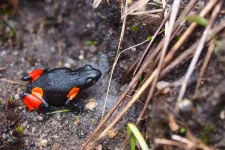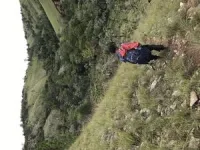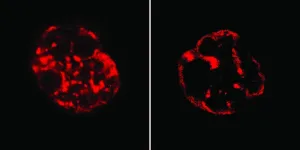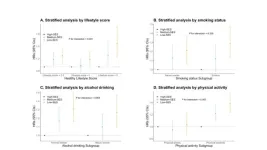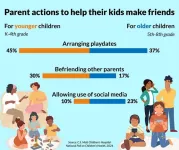(Press-News.org) New research highlights the precarious status of one of Madagascar's most threatened amphibians, the harlequin mantella (Mantella cowanii), revealing small population sizes and the possible extirpation of the species from several of its historic habitats. The findings underscore the urgent need for targeted conservation action to prevent the species from slipping further towards extinction.
Research Findings: A Dire Situation
Amphibians around the world are facing unprecedented population declines, and Mantella cowanii is no exception. The study, which focused on confirming the frog’s presence at historic localities and estimating its population size and survival rates, paints a concerning picture. Out of the 13 known localities for M. cowanii, the frog was detected in only 8, with 3 populations potentially extirpated. However, the research also uncovered two new populations, offering a glimmer of hope amidst the otherwise bleak outlook.
Repeated annual surveys at three sites revealed population sizes ranging from as few as 13 to 137 adults, with one site experiencing an alarming 80% reduction in population size from 2015 to 2023. The study also discovered that M. cowanii has a relatively slow life history pace, with adult survival rates between 0.529 and 0.618, and a maximum lifespan in the wild reaching nine years or more. This slower life history makes the species particularly vulnerable to extinction.
Threats to Mantella cowanii
The primary threats to Mantella cowanii include illegal collection for the international pet trade and ongoing habitat degradation. These pressures are compounded by the frog's limited distribution and small, isolated populations, which further increase its extinction risk.
Conservation Recommendations
In light of these findings, the researchers recommend immediate and sustained conservation efforts. Key actions include:
1. Continued Population Monitoring: Ongoing monitoring of M. cowanii populations is critical to track trends, measure the effectiveness of conservation actions, and detect declines before they become irreversible.
2. Reassessing the IUCN Red List Status: Given the recent population estimates and trends, there is a strong case for reassessing the species’ status on the IUCN Red List. Mantella cowanii was last assessed in 2014 as Endangered, but it may now qualify for the more severe Critically Endangered status.
3. Engaging Local Communities: Conservation efforts should involve local communities in monitoring programs, which can foster pride and support for the species while adding value to conservation initiatives.
4. Further Research: Additional research is needed to better understand the relative impact of threats such as disease, illegal trade, and habitat loss. This knowledge is essential to developing effective conservation strategies.
Global Implications
The challenges faced by Mantella cowanii are emblematic of a broader global trend in amphibian population declines. As amphibians are often indicators of environmental health, the decline of M. cowanii signals broader ecological challenges that could have far-reaching impacts.
Call to Action
The time to act is now. Conservationists, researchers, and policymakers must come together to implement the recommended actions and ensure the survival of Mantella cowanii. Without decisive intervention, we risk losing this unique species forever.
Press Pack: Images, Author Interview, Article PDF, Press Release
END
The American Academy of Sleep Medicine Foundation has joined forces with the Restless Legs Syndrome Foundation to fund research leading to new treatments and a cure for RLS.
Earlier this year, the AASM Foundation began an agreement with the RLS Foundation to co-fund basic and clinical RLS research. The partnership for 2024 includes the following research priorities:
Neurobiological interaction: Elucidate the points of interaction between RLS-relevant neurotransmitters, neuronal pathways, and iron deficiency.
Pharmacologic treatments: Elucidate effects of novel pharmacological approaches on RLS.
Clinical practice: Research based on innovations in patient ...
Discovery expands understanding of how language is produced by the brain
Current method of mapping brain language function for surgery using electrical stimulation hasn’t changed in 50 years
Finding could make it easier on patients and doctors to identify critical language sites in the brain to preserve function after surgery
CHICAGO --- When surgeons perform brain surgery on people with brain tumors or epilepsy, they need to remove the tumor or abnormal tissue while preserving parts of the brain that control language and movement.
A new Northwestern Medicine study may better inform doctors’ ...
Astronomers have used the NASA/ESA James Webb Space Telescope to confirm that supermassive black holes can starve their host galaxies of the fuel they need to form new stars.
The international team, co-led by the University of Cambridge, used Webb to observe a galaxy roughly the size of the Milky Way in the early universe, about two billion years after the Big Bang. Like most large galaxies, it has a supermassive black hole at its centre. However, this galaxy is essentially ‘dead’: it has mostly stopped forming new stars.
“Based ...
Imagine you’re looking at millions upon millions of mysterious genetic mutations. With CRISPR gene-editing technology, a select few of these mutations might have therapeutic potential. However, proving it would mean many thousands of hours of lab work. Just figuring out which ones are worth exploring further would take a lot of time and money. But what if you could do it in the virtual realm with artificial intelligence?
CREME is a new AI-powered virtual laboratory invented by Cold Spring Harbor Laboratory (CSHL) Assistant Professor Peter Koo and his team. It allows geneticists to run thousands of virtual experiments ...
Statement Highlights:
There are a variety of interrelated social and structural factors that contribute to differences in cardiovascular health among Asian Americans, and these factors are likely different within individual Asian ethnic subgroups.
Asian Americans and Asian immigrants are quite diverse and comprise many ethnic groups.
Social determinants, such as immigration-related factors, discrimination, socioeconomic status, English proficiency and cultural beliefs, may influence health behaviors, access to health care and the ability ...
Researchers from the Kind Group have gained new insights into the mechanism behind the spatial organization of DNA within the cells of early embryos. When an embryo is first formed after fertilization, each cell has the potential to become any cell type of the body. The researchers have studied the spatial organization of DNA that is so particular to these early developmental stages. The paper was published in Nature Genetics on September 16th, 2024.
Every cell in our body contains the same DNA. ...
A recent study conducted by researchers from Shanghai Jiao Tong University School of Medicine and Fudan University has revealed a significant association between socioeconomic status (SES) inequality and the risk of developing age-related macular degeneration (AMD). Published in Health Data Science, the study highlights how a healthy lifestyle can mitigate some of the risks associated with low SES.
Socioeconomic disparities have long been a concern in various health outcomes. This study, led ...
Researchers at Uppsala University have developed a gel inspired by cow slime for patients suffering from disc herniation. By adding the mucin gel immediately after surgery, it is possible to create a protective barrier around the discs to prevent the immune system from attacking their nucleus pulposus. This keeps the discs intact and reduces the risk of further damage.
“This new approach offers hope for those suffering from back pain caused by disc herniation and may prevent further damage after removing ...
ANN ARBOR, Mich. – Developing friendships is often seen as a natural part of childhood but it may be easier for some kids than others.
And many parents worry about their children’s friendships, according to the University of Michigan Health C.S. Mott Children’s Hospital National Poll on Children’s Health, with one in five saying their child ages six to 12 has no friends or not enough friends.
Ninety percent of parents believe their child would like to make new friends.
“Friendships can play a significant role in children’s overall health and development, emotional well-being, ...
Can artificial intelligence (AI) help reduce deaths in hospital? An AI-based system was able to reduce risk of unexpected deaths by identifying hospitalized patients at high risk of deteriorating health, found new research published in CMAJ (Canadian Medical Association Journal) https://www.cmaj.ca/lookup/doi/10.1503/cmaj.240132.
Rapid deterioration among hospitalized patients is the primary cause of unplanned admission to the intensive care unit (ICU). Previous research has attempted to use technology to identify these patients, but evidence is mixed about the application of prediction tools to ...
